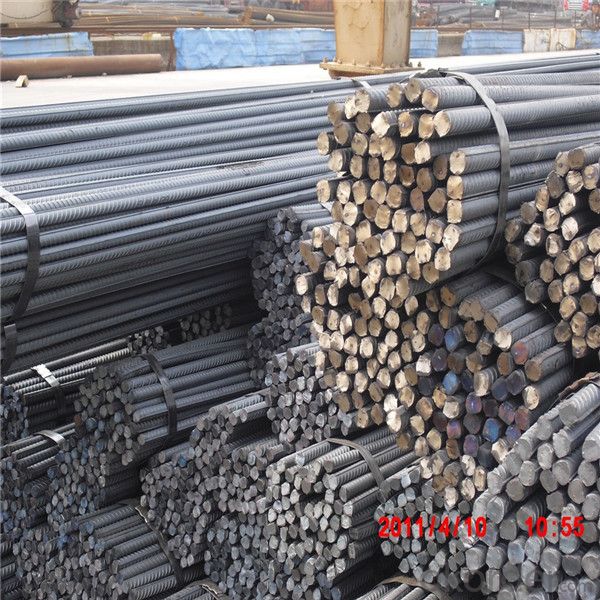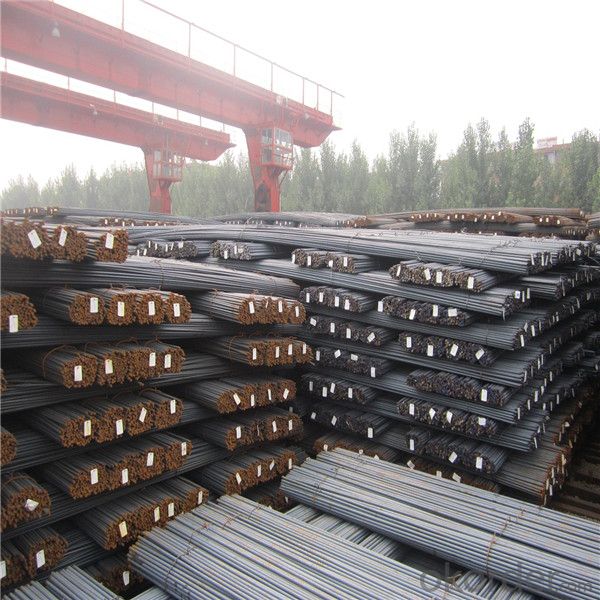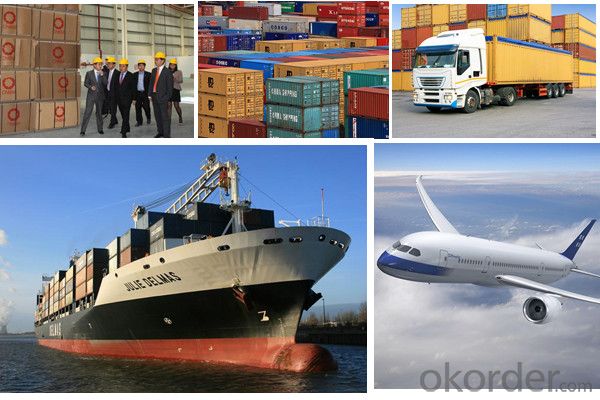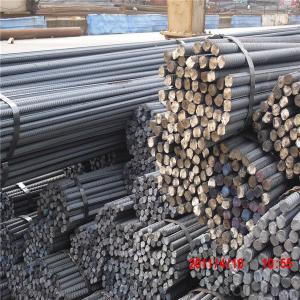TMT Reinforcing steel rebar Building Material
- Loading Port:
- Shanghai
- Payment Terms:
- TT OR LC
- Min Order Qty:
- 100 m.t.
- Supply Capability:
- 19000 m.t./month
OKorder Service Pledge
OKorder Financial Service
You Might Also Like
Item specifice
Steel rebar is bars of steel commonly used in construction, especially for reinforcing concrete structures such as
driveways, foundations, walls, and columns. These bars come in different sizes and strength grades, and can be smooth
or may include deformations that provide greater adhesion for concrete poured over the bars. When used in poured concrete,
the bars are typically placed in a grid pattern, the concrete poured over them, and then readjusted to maintain the proper shape
while the concrete sets. Steel rebar can be purchased from a number of manufacturers and is often found at construction retailers
or large hardware stores.
Features
1、Pure steel quality, stable chemical contents, small tolerance.
2、Constant Quality, good drawing performance.
3、High dimension accuracy degree, accuracy degree of Level C up to 80%, smooth surface, less scale, easy to be pickled.
4、Automatic bundling with 4 lines by Machine in tidy and good looks
5、Big high quality percentage, small coil percentage, and heavy coil weight for Hard Coil.
6、High sorbitizing percentage.
Product Description :
Chemical composition (%): | Steel | C | Si | Mn | P | S | Ceq | ||||
HRB335 |
0.25 |
0.80 |
1.60 |
0.045 |
0.045 | 0.52 | |||||
HRB400 | 0.54 | ||||||||||
HRB500 | 0.55 | ||||||||||
Mechanical properties | Steel | Rel/ MPa | Rm/ MPa | A/ % | Agt/ % | ||||||
≥ | |||||||||||
HRB335 | 335 | 455 | 17 |
7.5 | |||||||
HRB400 | 400 | 540 | 16 | ||||||||
HRB500 | 500 | 630 | 15 | ||||||||
Package: | Standard export packing or as customer's request | ||||||||||
Application: | Construction, building, bridge, road. ect | ||||||||||
Payment terms | 1).100% irrevocable L/C at sight. | ||||||||||
Delivery time | 15-30 days after receipt of L/C or deposit by T/T | ||||||||||


Packing:
In bundles, each bundle weight 3.5 tons. Load by container or by bulk verssel.


Our service
(1) We cooperate with famous factories with advanced equipment and well trained workers.
(2) We can provide factory price with trading company service.
(3) We continuously work on the improvement of our processes, guaranteeing consistently high standards
of quality to keep none compensation.
(4) We guarantee 24 hours response and 48 hours solution providing service.
(5) We accept small order quantity before formal cooperation.
(6) We deliver the agreed quality at the agreed time, reacting to changes in customer wishes in a flexible way.
(7) Due to our volume and selling power, we have excellent freight rates with shipping lines.
(8) We strive to always be fair and honest in our dealings with customers.
(9) We strive to work together with customers to achieve much more than we can achieve alone.
(10) Through our passion and commitment we aim to be a market leader in all our key markets. To maintain
our position as market leader we must continue to add value in all that we do.
FAQ:
1.Q: What's your MOQ(minimum order quantity)?
A: One full container, mixed acceptable .
2. Q: What's your packing methods?
A: Packed in bundle or bulk ..
3. Q: How can I buy CNBM products in my country?
A:Please send us an inquiry or email ,we will reply to you if there is distributor in your country
4. Q: Can we visit your factory?
A: Warmly welcome. Once we have your schedule, we will arrange the professional sales team to follow up your case.
5. Q: How long does it take to get the product if i place an order?
A:With the process of your requirements,we will pack and deliver in 3-7 days. If it is by sea shipment,it will take 15-45 days depending on different locations
- Q:What are the factors to consider while designing with steel rebars?
- There are several factors to consider while designing with steel rebars. 1. Strength and durability: The rebars should be selected based on the required strength and durability to withstand the anticipated loads and environmental conditions. 2. Size and shape: The size and shape of the rebars should be chosen to ensure proper placement, spacing, and anchorage within the concrete structure. 3. Corrosion resistance: The rebars should have adequate corrosion resistance, especially in environments where they may be exposed to moisture or chemicals. This can be achieved through proper material selection or by applying protective coatings. 4. Bond strength: The bond between the rebars and the concrete is crucial for transferring loads. The design should consider the factors that influence bond strength, such as surface roughness, bar diameter, and the use of proper concrete cover. 5. Construction constraints: The design should take into account any construction constraints, such as limitations in handling and placing the rebars, and ensure that the design is feasible and practical to implement. 6. Code compliance: Designing with steel rebars should adhere to relevant building codes and standards to ensure structural safety and regulatory compliance. By considering these factors, designers can create robust and reliable structures that effectively utilize the strength and versatility of steel rebars.
- Q:Can steel rebars be used in temporary structures?
- Yes, steel rebars can be used in temporary structures. Steel rebars provide structural reinforcement and can be used to strengthen concrete during construction. They can be easily installed and removed, making them suitable for temporary structures that require stability and durability.
- Q:Can steel rebars be used in structures with high resistance to earthquakes?
- Yes, steel rebars can be used in structures with high resistance to earthquakes. Steel rebars are commonly used in seismic-resistant structures due to their high tensile strength and ductility. They are able to absorb and dissipate the energy generated during an earthquake, providing reinforcement and stability to the structure. Additionally, modern construction techniques and design codes ensure that steel rebars are properly integrated into earthquake-resistant structures to enhance their overall resilience.
- Q:How do steel rebars affect the overall fire rating of a building?
- Steel rebars can have a positive impact on the overall fire rating of a building. By reinforcing concrete structures, rebars can help enhance the fire resistance of the building. Steel has high melting and ignition temperatures, which means it can withstand heat and maintain its structural integrity for longer periods during a fire. This additional durability provided by rebars can help prevent structural collapse, allowing occupants more time to evacuate safely and aiding firefighters in their efforts to suppress the fire.
- Q:How do steel rebars improve the structural integrity of concrete?
- Steel rebars improve the structural integrity of concrete in several ways. First and foremost, they enhance the tensile strength of concrete, which is otherwise weak in tension. Concrete has excellent compressive strength but lacks the ability to withstand pulling or stretching forces. By inserting steel rebars into the concrete, the tensile strength of the entire structure is significantly increased. The steel rebars act as reinforcement by distributing the stress and load across a wider area, preventing cracks and fractures from propagating through the concrete. They provide a strong bond between the concrete and the reinforcement, allowing the structure to bear heavy loads and resist bending, shearing, and other forces that can compromise its stability. Additionally, steel rebars help to control and mitigate the effects of shrinkage and thermal expansion and contraction that occur in concrete. These phenomena can often lead to cracking and structural damage. The steel rebars help to restrain the movement of the concrete, reducing the risk of cracks forming and ensuring the overall integrity of the structure. Furthermore, steel rebars increase the durability and longevity of concrete structures. They have high resistance to corrosion, which is especially important in environments with high moisture, chemicals, or saltwater exposure. The presence of steel rebars protects the concrete from deterioration and extends the lifespan of the structure. In summary, steel rebars play a crucial role in improving the structural integrity of concrete by enhancing its tensile strength, distributing stress and loads, preventing cracks, controlling shrinkage, resisting bending and shearing forces, and increasing durability. They provide a reliable and effective reinforcement system that ensures the stability and longevity of concrete structures.
- Q:What is the process of reinforcing existing concrete structures with steel rebars?
- Enhancing the strength and durability of existing concrete structures with steel rebars involves a series of steps. To begin, a thorough assessment of the concrete structure is conducted to determine its condition and identify areas in need of reinforcement. This involves inspecting the concrete for cracks, signs of degradation, or any other structural issues. Once the areas requiring reinforcement are identified, the next step is surface preparation. This involves cleaning the concrete surface to remove any loose debris, dirt, or contaminants that could hinder the bonding of the rebars with the concrete. Various methods, such as pressure washing or sandblasting, can be used for this purpose. Following surface preparation, the rebars are strategically placed within the concrete structure. The positioning and spacing of the rebars are crucial to ensure optimal reinforcement and structural integrity. This is typically accomplished by drilling holes or creating channels in the concrete where the rebars will be placed. Afterward, the rebars are inserted into the holes or channels, ensuring proper alignment and securing. The rebars are typically cut to the required length and bent into the desired shape to meet the specific reinforcement needs of the structure. Once the rebars are in place, they are anchored or secured to the existing concrete by various means. This can be achieved through the use of epoxy adhesive, mechanical anchors, or embedding the rebars into fresh concrete poured around them. Finally, the concrete is restored to its original condition, covering the rebars and creating a smooth and even surface. This may involve patching up any holes or channels created during the reinforcement process and finishing the surface to match the surrounding concrete. In conclusion, the process of reinforcing existing concrete structures with steel rebars necessitates careful planning, proper surface preparation, precise placement of rebars, secure anchoring, and appropriate finishing to achieve a strengthened and long-lasting structure.
- Q:What are the different types of steel rebars used in road constructions?
- Road constructions commonly utilize various types of steel rebars. These include: 1. Mild steel rebars: These are the most frequently employed rebars in road constructions. They consist of low carbon steel and possess a smooth surface. Mild steel rebars are renowned for their durability and strength, making them suitable for a range of road construction applications. 2. High-strength rebars: Crafted from high-strength steel, these rebars possess a greater yield strength compared to mild steel rebars. They are utilized in road constructions that require enhanced load-bearing capacity, such as bridges and highways. 3. Epoxy-coated rebars: These rebars are coated with epoxy resin to enhance their resistance to corrosion. They are commonly used in road constructions in areas exposed to moisture and chemicals, such as coastal regions. 4. Galvanized rebars: These rebars feature a zinc coating that provides protection against corrosion. They are particularly suitable for road constructions in regions with high humidity or a high risk of corrosion. 5. Stainless steel rebars: Constructed from stainless steel, these rebars exhibit exceptional corrosion resistance. They are frequently employed in road constructions that necessitate long-term durability and resistance to corrosion, such as tunnels and underground structures. Selecting the appropriate type of steel rebar for road constructions is crucial and should be based on specific project requirements, including load-bearing capacity, exposure to corrosion, and environmental conditions. Consulting structural engineers and adhering to local construction codes and standards is essential to ensure the successful implementation of road construction projects.
- Q:Can steel rebars be used in the construction of hotels and resorts?
- Yes, steel rebars can be used in the construction of hotels and resorts. In fact, steel rebars are commonly used in the construction industry for reinforcing concrete structures, including hotels and resorts, due to their excellent strength, durability, and ability to withstand heavy loads. They are crucial in providing structural stability and enhancing the overall safety and longevity of the buildings.
- Q:How do steel rebars affect the acoustic properties of a structure?
- The acoustic properties of a structure can be greatly influenced by steel rebars. This is due to their high density and rigidity, which allows them to conduct sound and vibrations effectively. As a result, when sound waves or vibrations encounter steel rebars, they can easily pass through them, resulting in higher levels of noise and reduced acoustic insulation. Regarding airborne sound transmission, steel rebars can create a direct pathway for sound waves to travel through a structure. This can lead to sound amplification, especially in areas where rebars directly contact walls or floors. Consequently, the overall acoustic quality of the structure may be compromised, resulting in increased noise levels and decreased speech intelligibility. Steel rebars can also impact a structure's ability to block impact or structure-borne noise. For instance, when vibrations are generated from activities like walking or machinery, the rigid steel rebars can efficiently transmit these vibrations throughout the structure. This can cause the amplification and propagation of structure-borne noise, making it more noticeable in various areas of the building. To minimize the negative effects of steel rebars on a structure's acoustic properties, various techniques can be employed. One common method is to use acoustically decoupled materials or resilient mounts to isolate the rebars from the surrounding structure, reducing the transmission of vibrations. Additionally, incorporating sound-absorbing materials like acoustic panels or insulation can help absorb and dampen sound waves, improving the overall acoustic performance of the space. In conclusion, steel rebars can significantly impact the acoustic properties of a structure due to their high density and rigidity. They can efficiently conduct sound and vibrations, leading to increased noise levels and reduced acoustic insulation. Therefore, careful consideration of acoustic design and the appropriate use of soundproofing measures are crucial in minimizing the adverse effects of steel rebars on a building's acoustic quality.
- Q:What are the different types of steel rebars used in column reinforcement?
- There are several types of steel rebars used in column reinforcement, including mild steel rebars, high-strength rebars, epoxy-coated rebars, and stainless steel rebars.
1. Manufacturer Overview |
|
|---|---|
| Location | |
| Year Established | |
| Annual Output Value | |
| Main Markets | |
| Company Certifications | |
2. Manufacturer Certificates |
|
|---|---|
| a) Certification Name | |
| Range | |
| Reference | |
| Validity Period | |
3. Manufacturer Capability |
|
|---|---|
| a)Trade Capacity | |
| Nearest Port | |
| Export Percentage | |
| No.of Employees in Trade Department | |
| Language Spoken: | |
| b)Factory Information | |
| Factory Size: | |
| No. of Production Lines | |
| Contract Manufacturing | |
| Product Price Range | |
Send your message to us
TMT Reinforcing steel rebar Building Material
- Loading Port:
- Shanghai
- Payment Terms:
- TT OR LC
- Min Order Qty:
- 100 m.t.
- Supply Capability:
- 19000 m.t./month
OKorder Service Pledge
OKorder Financial Service
Similar products
New products
Hot products
Related keywords



























